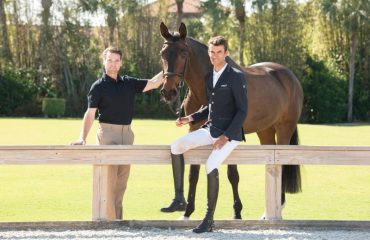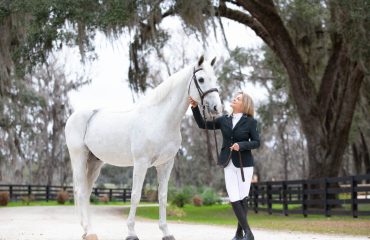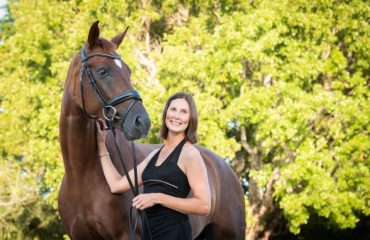Sideline’s Favorite Mystery Writer Tami Hoag
By Jan Westmark-Allan
Tami Hoag is a great many things: a world-famous New York Times bestselling mystery and thriller writer with more than 35 million books in print in more than 20 languages; an extraordinary horsewoman and dressage rider who competes on the Grand Prix circuit, first as an amateur and now as a professional; a goal-oriented person who in addition to writing non-stop has competed at Devon and has a stable full of horses; a funny lady with a wicked sense of humor (see her answer below about how many horses she owns); and, last but not least, Tami is a friend of Sidelines Magazine.
In 2002, Tami wrote the suspenseful page-turning novel Dark Horse, set in Wellington on the show jumping circuit. (A must-read for horse people, especially if you have ever visited Wellington). The book is a glimpse into the dark side of the equestrian world and while the novel had horse people everywhere trying to guess who was who, the book is, in fact, fiction. There are a few parts based on real life, however, including Tami’s horse D’Artagnon who appears in the book and a mention of Sidelines Magazine. When Elena Estes, the main character in Dark Horse, looks for a job she turns to the classified section of Sidelines, thus introducing readers around the world to the magazine. Thanks Tami!
“I wrote Dark Horse back in the day when Sidelines was still done as a newspaper rather than in the magazine format. It’s such a fixture of life here among the horsey set, I couldn’t write a book set in Wellington without mentioning it!” Tami said.
Since Dark Horse was published, Tami has written several more novels including the sequel to Dark Horse called The Alibi Man, another spine-tingling tale set in the horse world featuring Elena Estes. We caught up with Tami at her home in Wellington, where she is glued to her computer as she pounds out yet another novel. Despite the fact that Tami is known to her fans as a writer, she is known to many as a rider. In fact she has her sights set on competing in the Olympic trials. So in her own words, Tami tells us first about her literary life and then about her real passion – her horses – ending with great advice for would-be writers and riders everywhere!
Sidelines: Fans are always asking you if there will be a third Elena Estes novel. Will you write again about the horse world?
TH: First of all, I’m really glad that fans connected with Elena. She’s a complex and difficult character, and I love writing her. I would love to do another book with her at the center of it, but she’s got to wait her turn. For me, ideas are like planes waiting in line for the runway. There are a couple on the tarmac ahead of her.
Sidelines: Do you have a favorite book that you have written?
TH: People never believe this, but I don’t play favorites. Each book is its own unique experience, and once I’m done with it, I move on to the next.
Sidelines: How do you balance your writing career with you riding career?
TH: I’m under contract to do a book a year. I have worked faster than that, but it about killed me, and left me no time or energy to have a life outside my office. My horses are a big priority for me. I’m at a point in my life where I’m simply not willing to compromise on certain things like pursuing my riding career and spending time with my friends. I always say no one will be on their deathbed wishing they had given up the things they love in order to work more.
Sidelines: What book are you working on now?
TH: I’m working on a book called Down the Darkest Road, which is set to be released at the end of the year. It’s the third in the series that began with Deeper Than The Dead and Secrets To The Grave. The story revolves around a woman whose sixteen-year-old daughter was abducted and has been missing for four years. She doesn’t know if her child is living or dead. She — and the police — believe they know who the perpetrator is, but they have no physical evidence against him. All they have is a tiny blood sample that may or may not belong to the girl. The book takes place in 1990, when DNA technology was in its infancy, and a substantial sample was needed for testing. In this case, the sample is so small that testing it would destroy it and leave them with nothing. They need to wait until the technology advances. But the mother is at the end of her rope, and has reached a point where she may be driven to make something happen. It’s very much a psychological thriller.
Sidelines: What is the best part of being a writer?
TH: When the words are coming with such a flow that I feel like I’m just a scribe for some incredible creative energy in the universe. That’s amazing. I also like going to work in sweats and not having to wear makeup. And of course I love meeting readers and knowing that what I do touches them and entertains them. That’s a great privilege for which I am enormously thankful.
Sidelines: What did if feel like the first time one of your books made it onto the New York Times bestselling list?
TH: It’s always a thrill. My first was Night Sins. I think it was 1995. I wouldn’t truly believe it until I had the list in my hands and could read it with my own eyes. I think I’ve now had fourteen NYT Bestsellers. Every book I’ve had released since that one has made it, both in hardcover and in paperback, which is incredible. But now it’s expected by my publisher, which brings a lot of pressure on me for something I have absolutely no control over. Now when the news comes, it’s more of a relief first, and cause for celebration second.
Sidelines: Did you dream your writing career would turn out to be so successful?
TH: Yes, actually. I’m a very goal-driven person. I can never just do something. I have to do it in a big way. I feel obligated to succeed. And my attitude going in before I was published was this: If one in a million is going to make it, it might as well be me.
Sidelines: You just sold your house in California and are now living in Wellington year-round; why the move?
TH: I loved LA for myself. The prevailing attitude there is “Why not?” It’s a town that was truly founded on dreams, and dreamers are welcomed with open arms. That’s a very freeing and stimulating atmosphere for an artist. But I found it very frustrating to have my horses there. In Wellington we are spoiled for excellent choices in facilities, veterinarians, farriers, etc. Horses and the care of horses are such a priority here. Also, there is such a feeling of community for horse people. One never lacks for dinner companions willing to talk about nothing but horses. We’re like a big crazy family all in one town. In LA everyone is scattered around. I had to drive 45 minutes one-way to get to the barn. No one in my neighborhood had horses or understood people who have horses — nor did they care to. Then there’s the fact that no place in the United States can compare to Wellington when it comes to horses shows — especially for dressage. And that is only going to become more so in the future with our new and improved venues, the draw of riders from Europe and the concentration of top-level competitions.
Sidelines: What are your goals in the writing world?
TH: In the mundane sense, more #1 bestsellers, bigger sales figures, movie deals. In the artistic sense, I want to continue to grow in terms of the depth and complexity of my writing. I really enjoy what I do, writing thrillers. I don’t have any plan to change genres, but perhaps to explore writing about crime from different angles. I see that happening already with Down The Darkest Road.
Sidelines: Now it’s time to confess – how many horses do you own?
TH: Ha! Well, since my business manager probably isn’t going to read this . . . I have three here in Wellington, one retired horse in California and a young horse in training in California. And of course I’m always trying to find a way to get another! I’m an addict. What can I say? It beats smoking crack. It’s probably not cheaper, though.
Sidelines: What horses are you showing?
TH: I’ll be going back to the show ring in the fall with Lonestar and Bacchus. They’re both Grand Prix horses, and we’ll be showing in the CDIs. Like every other Grand Prix rider in the country, my goal for 2012 will be to go to the Olympic trials.
Sidelines: What have you learned from your longtime trainer Betsy Steiner?
TH: Betsy has been my friend and mentor for more than a decade now. I can literally read her mind during a training session. I tell her all the time, “I don’t know why you bother to speak. I know exactly what you’re going to ask me to do!” From Betsy I have learned so many important things: the importance of developing a classical seat and position; to love and appreciate the complexities of the so-called “basic” work; to ride not only with my body, but with my mind and with my soul; to be able to visualize the concepts we talk about in theory, and to manifest them. I’m incredibly blessed to have such a teacher, and to have that teacher also be such a loyal and true friend.
Sidelines: When you first discovered dressage did you think you would make it to the Grand Prix level?
TH: Of course! I would never think any other way!
Sidelines: What do you consider some of your riding highlights?
TH: Oh, my goodness, there have been so many. Qualifying for Devon and regional championships at my very first dressage show — which was Raleigh! Scoring a 70 in my first Prix St. Georges that same summer. Placing twice in the open division at Devon that fall. Mastering riding that horse in a snaffle — a goal not for the faint of heart, I assure you! Placing in my first ever Grand Prix with Feliki at the Gold Coast Opener in 2001, in a huge open class. Winning the Dressage Under the Stars Freestyle Championship with her in 2010 after everyone had told me in 2007 that she would never come back from an injury and that I should retire her. Riding the Pas de Deux on Coco Chanel, with Betsy on Feliki, for Team USA in the Challenge of the Americas in 2006. We had three days to prepare that freestyle from scratch, and it was our score that won the overall championship for the team. That was a magical evening, and will always be one of my most cherished memories with Coco.
Sidelines: Do you have a favorite horse?
TH: I have been absolutely blessed to have had some truly extraordinary horses come to me. My first dressage horse, D’Artagnon, was an extremely difficult horse to ride, but I knew when I bought him that he would make me a better rider, and he did. On him I went from never having ridden a test to being one of the top amateur PSG riders in the country in just two seasons. Then Feliki came to me. I wasn’t looking for her. I had to be talked into buying her because I was afraid that at 13 I would have only a couple of seasons with her. She is 24 this year and still challenges me every day to become better. What I have learned from her goes so far beyond riding. She is my example of how to live: With fierce intent. To never say never. To never give in without good reason. And not to judge myself by a calendar. Coco Chanel was special the way angels are special. Bacchus has continued the lessons Feliki began. I was told in 2008 he would never come back from a near-catastrophic suspensory injury, but I stuck it out and stuck it out and stuck it out with him. He came back into real work a year ago, and he rewards me for my belief in him every day. Our best years are still to come. Lonestar has given me trust and faith in my own abilities, not just as a rider, but as a trainer.
Sidelines: You were injured not long ago, what happened?
TH: That all started with my love for bad boys and sad stories of talented, but misunderstood horses. Rush Hour is a horse with a wealth of talent, but a few unfortunate personality “quirks” I was willing to deal with. Long story short, I took my attention off him for a split second on a day I shouldn’t have, and he planted me in the dirt with serious intent. That’s no mean feat on his part. I do not come off horses but once every ten years or so, and not for lack of trying on the horses part. I don’t ride easy horses. If there isn’t a challenge in there somewhere, I’m not interested. Anyway, I blew out my left knee entirely and was very lucky not to have broken my pelvis and/or my back (I was, however, solid purple from waist to the back of my knee for almost two months.) All told, I was out of the saddle for the better part of three months, and missed most of the season. I was extremely depressed about it, but I also knew that I could have very easily been killed that day, and I wasn’t. I was very lucky to avoid major knee surgery, thanks to Dr. Craig Ferrell at Vanderbilt Bone and Joint. I’m back riding full-on, three a day as of the end of May. The knee is still not stable laterally, and will probably never be, but I can ride, and that’s all I care about.
Sidelines: What are your riding goals?
TH: My overall goal is continue to study in the classical school and to be able to help my horses to be all they can be. In the show ring, I want to have that little American flag sewn onto the breast pocket of my tailcoat. I want to be 100 years old showing all the folks in the rest home pictures of me riding in the big shows in Europe.
Sidelines: You donated one of your horses to University of Findlay, what was behind that decision?
TH: I had a terrific FEI prospect in a gorgeous boy called Fhilosopher. Unfortunately, Fhil developed some physical limitations that would prevent him from achieving those top-level goals. I didn’t want to sell him, because I knew no matter what any buyer might say, they would not be able to resist the temptation of pushing him beyond what he was comfortably physically able to do. Instead, I chose to donate him to Findlay where I knew he would be doted on by teenage girls every day of his life, and he could be a superstar at the lower levels. It was a win-win for all involved.
Sidelines: What do you like best about horses?
TH: Their honesty. You always know where you stand with a horse.
Sidelines: To all aspiring writers and riders out there who read Sidelines, what advice can you share from what you have learned?
TH: Make a goal and don’t let anybody tell you that you can’t achieve it.















